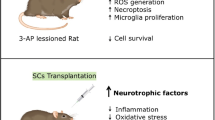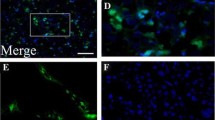Abstract
Cerebellar ataxia (CA) is a form of ataxia that adversely affects the cerebellum. Cell replacement therapy (CRT) has been considered as a potential treatment for neurological disorders. In this report, we investigated the neuro-restorative effects of human chorionic stem cells (HCSCs) transplantation on rat model of CA induced by 3-acetylpyridine (3-AP). In this regard, HCSCs were isolated and phenotypically determined. Next, a single injection of 3-AP was administered for ataxia induction, and bilateral HCSCs implantation was conducted 3 days after 3-AP injection, followed by expression analysis of a number of apoptotic, autophagic and inflammatory genes as well as vascular endothelial growth factor (VEGF) level, along with assessment of cerebellar neurodegeneration, motor coordination and muscle activity. The findings revealed that grafting of HCSCs in 3-AP model of ataxia decreased the expression levels of several inflammatory, autophagic and apoptotic genes and provoked the up-regulation of VEGF in the cerebellar region, prevented the degeneration of Purkinje cells caused by 3-AP toxicity and ameliorated motor coordination and muscle function. In conclusion, these data indicate in vivo efficacy of HCSCs in the reestablishment of motor skills and reversal of CA.




Similar content being viewed by others
References
Ahmadi H et al (2018) Sertoli cells avert neuroinflammation-induced cell death and improve motor function and striatal atrophy in rat model of Huntington disease. J Mol Neurosci 65:17–27
Aliaghaei A, Boroujeni ME, Ahmadi H, Bayat AH, Tavirani MR, Abdollahifar MA, Pooyafar MH, Mansouri V (2019a) Dental pulp stem cell transplantation ameliorates motor function and prevents cerebellar atrophy in rat model of cerebellar ataxia. Cell Tissue Res 376(2):179–187
Aliaghaei A, Meymand AZ, Boroujeni ME, Khodagoli F, Meftahi GH, Hadipour MM, Abdollahifar MA, Mesgar S, Ahmadi H, Danyali S, Hasani S (2019b) Neuro-restorative effect of sertoli cell transplants in a rat model of amyloid beta toxicity. Behav Brain Res 367:158–165
Alizadeh R, Mehrabi S, Hadjighassem M (2013) Cell therapy in Parkinson’s disease. Arch Neurosci 1:43–50
Alizadeh R, Hassanzadeh G, Soleimani M, Taghi Joghataei M, Siavashi V, Khorgami Z, Hadjighassem M (2015) Gender and age related changes in number of dopaminergic neurons in adult human olfactory bulb. J Chem Neuroanat 69:1–6
Alizadeh R et al (2017) In vitro differentiation of neural stem cells derived from human olfactory bulb into dopaminergic-like neurons. Eur J Neurosci 45:773–784
Alizadeh R et al (2019a) Human olfactory stem cells: as a promising source of dopaminergic neuron-like cells for treatment of Parkinson's disease. Neurosci Lett 696:52–59
Alizadeh R, Ramezanpour F, Mohammadi A, Eftekharzadeh M, Simorgh S, Kazemiha M, Moradi F (2019b) Differentiation of human olfactory system‐derived stem cells into dopaminergic neuron‐like cells: A comparison between olfactory bulb and mucosa as two sources of stem cells. J Cell Biochem 120(12):19712–19720
Anzalone R, Iacono ML, Loria T, Di Stefano A, Giannuzzi P, Farina F, La Rocca G (2011) Wharton’s jelly mesenchymal stem cells as candidates for beta cells regeneration: extending the differentiative and immunomodulatory benefits of adult mesenchymal stem cells for the treatment of type 1 diabetes. Stem Cell Rev 7:342–363
Aoki H, Sugihara I (2012) Morphology of single olivocerebellar axons in the denervation–reinnervation model produced by subtotal lesion of the rat inferior olive. Brain Res 1449:24–37
Bagher Z et al (2018) Differentiation of neural crest stem cells from nasal mucosa into motor neuron-like cells chemical. J Neuroanat 92:35–40. https://doi.org/10.1016/j.jchemneu.2018.05.003
Bagher Z, Atoufi Z, Alizadeh R, Farhadi M, Zarrintaj P, Moroni L, Setayeshmehr M, Komeili A, Kamrava SK (2019) Conductive hydrogel based on chitosananiline pentamer/gelatin/agarose significantly promoted motor neuron-like cells differentiation of human olfactory ecto-mesenchymal stem cells. Mater Sci Eng C 101:243–253
Battula VL, Treml S, Abele H, Bühring H-J (2008) Prospective isolation and characterization of mesenchymal stem cells from human placenta using a frizzled-9-specific monoclonal antibody. Differentiation 76:326–336
Benirschke K, Driscoll SG (1967) The pathology of the human placenta. In: InPlacenta. Springer, Berlin, Heidelberg, pp 97–571
Boroujeni ME, Gardaneh M (2017) Umbilical cord: an unlimited source of cells differentiable towards dopaminergic neurons. Neural Regen Res 12:1186
Boroujeni ME, Gardaneh M, Shahriari MH, Aliaghaei A, Hasani S (2017) Synergy between choroid plexus epithelial cell-conditioned medium and knockout serum replacement converts human adipose-derived stem cells to dopamine-secreting neurons. Rejuvenation Res 20(4):309–319
Bradford MM (1976) A rapid and sensitive method for the quantitation of microgram quantities of protein utilizing the principle of protein-dye binding. Analytical Biochemistry 72(1–2):248–54
Castrechini N et al (2010) Mesenchymal stem cells in human placental chorionic villi reside in a vascular niche. Placenta 31:203–212
Cendelín J, Voller J, Vožeh F (2010) Ataxic gait analysis in a mouse model of the olivocerebellar degeneration. Behav Brain Res 210(1):8–15
Duffy AM, Bouchier-Hayes DJ, Harmey JH (2004) Vascular Endothelial Growth Factor (VEGF). Vegf and Cancer 133
Dulamea A (2015) Mesenchymal stem cells in multiple sclerosis-translation to clinical trials. J Med Life 8:24
Ebrahimi MJ et al (2018) Human umbilical cord matrix stem cells reverse oxidative stress-induced cell death and ameliorate motor function and striatal atrophy in rat model of Huntington disease. Neurotox Res 34:273–284
Eskandarian Boroujeni M, Peirouvi T, Shaerzadeh F, Ahmadiani A, Abdollahifar MA, Aliaghaei A (2020) Differential gene expression and stereological analyses of the cerebellum following methamphetamine exposure. Addict Biol 25(1):e12707
Fernandez A, De La Vega AG, Torres-Aleman I (1998) Insulin-like growth factor I restores motor coordination in a rat model of cerebellar ataxia. Proc Natl Acad Sci 95:1253–1258
Gugliandolo A, Bramanti P, Mazzon E (2017) Mesenchymal stem cell therapy in Parkinson's disease animal models. Curr Res Transl Med 65:51–60
Hasani S, Boroujeni ME, Aliaghaei A, Baghai K, Rostami A (2018) Dopaminergic induction of human adipose-derived mesenchymal stem cells is accompanied by transcriptional activation of autophagy. Cell Biol Int 42:1688–1694
Hoban D, Howard L, Dowd E (2015) GDNF-secreting mesenchymal stem cells provide localized neuroprotection in an inflammation-driven rat model of Parkinson’s disease. Neuroscience 303:402–411
Kurozumi K, Nakamura K, Tamiya T, Kawano Y, Ishii K, Kobune M, Hirai S, Uchida H, Sasaki K, Ito Y, Kato K, Honmou O, Houkin K, Date I, Hamada H (2005) Mesenchymal stem cells that produce neurotrophic factors reduce ischemic damage in the rat middle cerebral artery occlusion model. Mol Ther 11:96–104
Kwon A et al (2016) Tissue-specific differentiation potency of mesenchymal stromal cells from perinatal tissues. Sci Rep 6:23544
Lastres-Becker I, Rüb U, Auburger G (2008) Spinocerebellar ataxia 2 (SCA2). Cerebellum 7:115–124
Lindvall O, Kokaia Z, Martinez-Serrano A (2004) Stem cell therapy for human neurodegenerative disorders–how to make it work. Nat Med 10:S42
Liu L et al (2010) Mesenchymal stem cells inhibition of chronic ethanol-induced oxidative damage via upregulation of phosphatidylinositol-3-kinase/Akt and modulation of extracellular signal-regulated kinase 1/2 activation in PC12 cells and neurons. neuroscience 167:1115–1124
Mahmoudi M, Bayat AH, Boroujeni ME, Abdollahifar MA, Ebrahimi V, Danyali S, Heidari MH, Aliaghaei A (2019) Curcumin protects purkinje neurons, ameliorates motor function and reduces cerebellar atrophy in rat model of cerebellar ataxia induced by 3-AP. J Chem Neuroanat 102:101706
Manochantr S, Marupanthorn K, Tantrawatpan C, Kheolamai P (2015) The expression of neurogenic markers after neuronal induction of chorion-derived mesenchymal stromal cells. Neurol Res 37:545–552
Manto M, Marmolino D (2009) Cerebellar ataxias. Curr Opin Neurol 22:419–429
Marmolino D, Manto M (2010) Past, present and future therapeutics for cerebellar ataxias. Curr Neuropharmacol 8:41–61
Maucksch C, Vazey EM, Gordon RJ, Connor B (2013) Stem cell-based therapy for Huntington's disease. J Cell Biochem 114:754–763
Moayeri A, Bojnordi MN, Haratizadeh S, Esmaeilnejad-Moghadam A, Alizadeh R, Hamidabadi HG (2017) Transdifferentiation of human dental pulp stem cells into oligoprogenitor cells Basic and clinical. neuroscience 8:387
Mohammadi A et al (2019) Transplantation of human chorion-derived cholinergic progenitor cells: a novel treatment for neurological disorders. Mol Neurobiol 56:307–318
Namjoo Z et al (2018a) Combined effects of rat Schwann cells and 17β-estradiol in a spinal cord injury model. Metab Brain Dis 33:1229–1242
Namjoo Z, Mortezaee K, Joghataei MT, Moradi F, Piryaei A, Abbasi Y, Hosseini A, Majidpoor J (2018b) Targeting axonal degeneration and demyelination using combination administration of 17β-estradiol and Schwann cells in the rat model of spinal cord injury. J Cell Biochem 119:10195–10203
Nazarov I et al (2012) Multipotent stromal stem cells from human placenta demonstrate high therapeutic potential. Stem Cells Transl Med 1:359–372
Nur Fariha M-M, Chua K-H, Tan G-C, Tan A-E, Hayati A-R (2011) Human chorion-derived stem cells: changes in stem cell properties during serial passage. Cytotherapy 13:582–593
Parolini O et al (2008) Concise review: isolation and characterization of cells from human term placenta: outcome of the first international workshop on placenta derived stem cells stem. Cells 26:300–311
Qu J, Zhang H (2017) Roles of mesenchymal stem cells in spinal cord injury. Stem Cells Int 2017
Salehi M et al (2019) Alginate/chitosan hydrogel containing olfactory ectomesenchymal stem cells for sciatic nerve tissue engineering. J Cell Physiol. https://doi.org/10.1002/jcp.28183
Simorgh S et al (2019) Olfactory mucosa stem cells: an available candidate for the treatment of the Parkinson's disease. J Cell Physiol. https://doi.org/10.1002/jcp.28944
Tatullo M, Marrelli M, Paduano F (2015) The regenerative medicine in oral and maxillofacial surgery: the most important innovations in the clinical application of mesenchymal stem cells. Int J Med Sci 12:72
Wecker L, Marrero-Rosado B, Engberg M, Johns B, Philpot R (2017) 3-Acetylpyridine neurotoxicity in mice. Neurotoxicology 58:143–152
Zhang M-J, Sun JJ, Qian L, Liu Z, Zhang Z, Cao W, Li W, Xu Y (2011) Human umbilical mesenchymal stem cells enhance the expression of neurotrophic factors and protect ataxic mice. Brain Res 1402:122–131
Acknowledgements
The authors would like to thank the Clinical Research Development Unit (CRDU) of Loghman Hakim Hospital and Shahid Beheshti University of Medical Sciences, Tehran, Iran for their support, cooperation and assistance throughout the period of study (grant number 14231).
Author information
Authors and Affiliations
Corresponding authors
Ethics declarations
Conflict of interest
The authors declare that they have no conflict of interest.
Informed consent
Informed consent was obtained from all individual participants included in the study.
Ethical approval
All experiments were done in accordance with the National Institutes of Health Guide for the Care and Use of Laboratory Animals (NIH Publication No. 80–23, revised 1996) and were approved by the Research and Ethics Committee of Shahid Beheshti University of Medical Sciences, Tehran, Iran, under approval NO. IR. SBMU. REC. 1397.007.
Additional information
Publisher’s note
Springer Nature remains neutral with regard to jurisdictional claims in published maps and institutional affiliations.
Rights and permissions
About this article
Cite this article
Akhlaghpasand, M., Tizro, M., Raoofi, A. et al. Grafted human chorionic stem cells restore motor function and preclude cerebellar neurodegeneration in rat model of cerebellar ataxia. Metab Brain Dis 35, 615–625 (2020). https://doi.org/10.1007/s11011-020-00543-0
Received:
Accepted:
Published:
Issue Date:
DOI: https://doi.org/10.1007/s11011-020-00543-0




